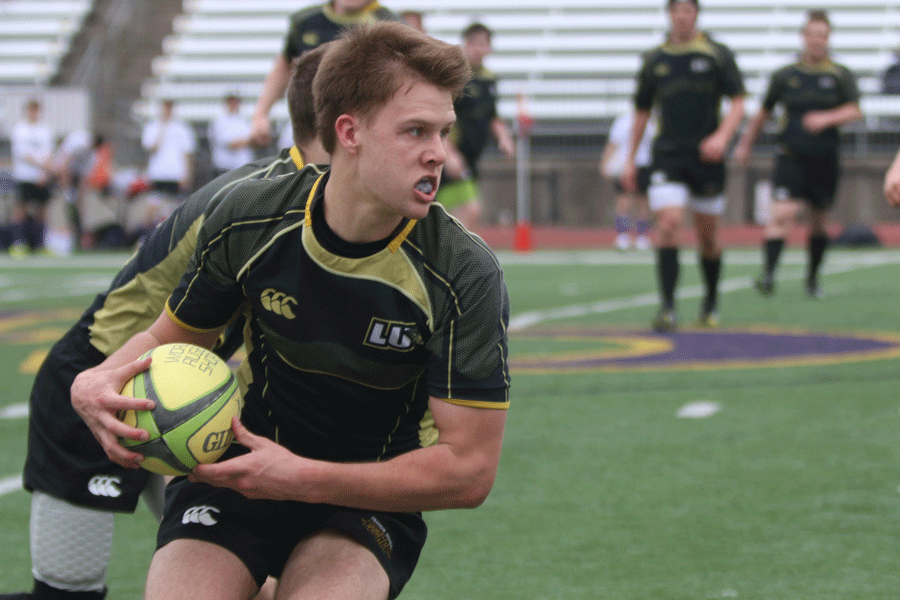Everything You Need to Know About Positions in Rugby
Credit to File Photo
Rugby player takes possession of the ball in an away rugby match.
Published: March 22, 2018
Loose-head-prop, Tight-head-prop
They make up what is known as the front row. This refers to their position in the scrum. Props are normally bigger guys who have to handle head-to-head competition. The scrums support the hookers body weight, allowing them to see and strike the ball when it is put into the scrum. Besides this they help secure the ball when a player gets tackled.
Locks
The two locks are in the second row of forwards. These players need to be tall and powerful because they are the target men in the lineout. Normally, these players are the ball carriers. Most of the time they are the tallest members of the team.
Number Eight
Support plays, tackling and ball-carrying is what this guy is supposed to specialize in. His duties are similar to that of the flanker, and together, they make up what is known as the back row. He is the only player who is allowed to pick the ball up from the base of the scrum.
Fly-Half
They are arguably the most important player on the pitch. Nearly every attack will pass through the fly half. They must be strong in tackling because they are responsible for defending the team’s open-source flanker. They are also the ones who kick it down the field to gain a better position.
Left-Wing, Right Wing
They are the finisher in attack, the last line of defense when the ball is not in their possession. Because of this, they need to be fast.
Hooker
They line up between the two props. They are responsible for winning possession of the ball in the scrummage. Hooker is normally the smallest member of the front row because of the fact that the props must support his weight. They are also responsible for throwing in the ball in at the line out to the line out jumper.
Blind-Side Flanker, Open-Side Flanker
These players are known to have less responsibility, but they still must be good at speed strength, tackling and handling. They are usually at the center of the action and are supposed to win the balls from ruck and mauls. They also collect balls from tackled players along with making their own tackles.
Scrum-Half
This person is the link between the forwards and backs. They line up directly behind the forwards and control when the ball is taken out to the backs from the rear of the scrum. They tend to be one of the smaller players on the team.
Inside-Centre, Outside Center
There are two centers: the inside center and the outside center. Both must be dynamic runners and be able to find holes in the gaps since they act also as the team’s ball handlers. Their main job is to either try and break the defensive line or create opportunities for their teammates to try and score.
Full-Back
They are behind the entire back line. They must be comfortable catching high balls because they are the ones who receive them. They also must know when to counter kick or when to run. They must be fast with their decisions.
“I’ve been playing for three years. It’s just a fun sport in general. It’s not like your average sport.”
-Conner Hodgkins, 11, plays hooker
“I’ve been playing rugby for four years. Rugby is a really fun sport. I’ve grown up doing contact sports so it’s just something that I fit into.”
-Hunter Collins, 12, plays scrum half
“I’ve been playing for four years. The reason that I play is because it reminds me of football and there’s a lot more technique. You have to put a lot of trust into your teammates. You build strong relationships with your teammates.”
-Bon Jang, 12, plays inside center
“This is my first year playing. I joined because the sport seemed interesting. Also I’ve always had a love for sports and staying fit.”
-Kyle Mccrary, 9, plays right wing
“I started playing freshman year here. I like playing because it’s a very competitive sport. It’s very physical. You put a lot of trust into your teammates. Its very fast pace. It’s a lot of fun.”
-Floris Kruger, 12, plays flanker








![JV Girls Basketball Takes A Win To FZE On The First Game Of The Season [Photo Gallery]](https://FHNtoday.com/wp-content/uploads/2024/12/voccer10.24_kwallace-3-300x200.jpg)
![It's Time for the BOE to Respect Student Input [Editorial]](https://FHNtoday.com/wp-content/uploads/2024/11/Untitled_Artwork-1-300x173.png)



